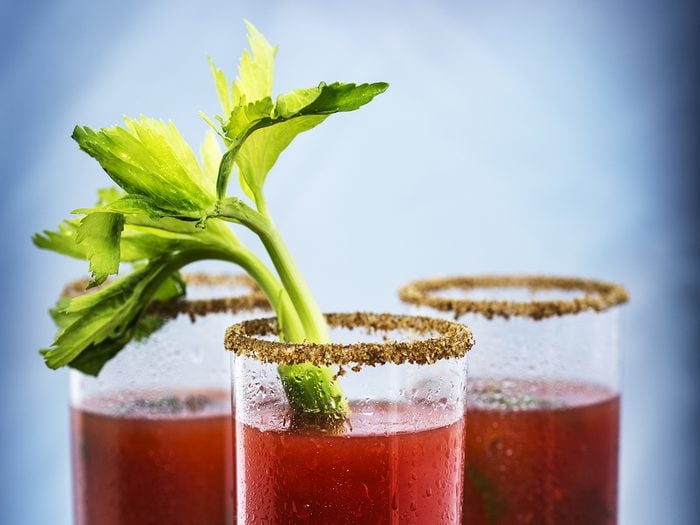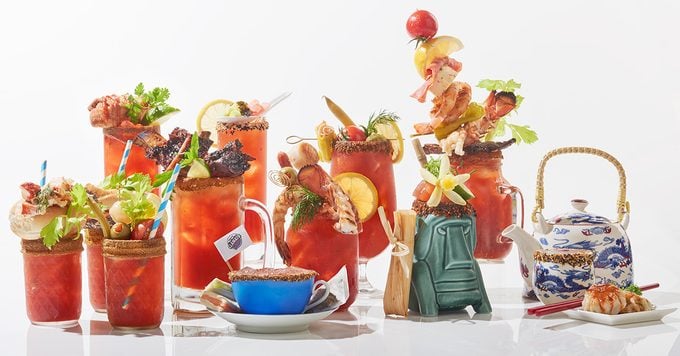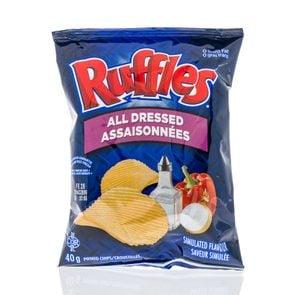How the Caesar Became Canada’s Favourite Cocktail

Who really invented the Caesar? And why do Canadians love it so much? Learn how this cocktail won over the north.
I had my first Caesar when I was 19. My mom made one for me. Knowing I’m not the biggest fan of seafood, she didn’t explain that there was clam juice in it. I took my first sip of this unfamiliar concoction—a blend of vodka, tomato juice, clam broth, hot sauce and Worcestershire sauce—and knew I’d found my soulmate in cocktail form.
You don’t drink a Caesar as much as you savour it—the combined intensity of flavours, spice and saltiness force you to sip more slowly than you would a glass of wine or a pint of beer. “Mindful” may be a widely-used buzzword nowadays, but that’s exactly how I feel when I have a Caesar in hand.
And of course, I’m not alone.
On average, Canadians consume a whopping 350 million Caesars every year. In 2007, viewers of the CBC television special The Greatest Canadian Invention voted it 13th—beating out the likes of basketball, lacrosse and the Canadarm. And two years later, an Ipsos-Reid poll determined it was the country’s most popular cocktail.
But there’s more to the Caesar than meets the eye. Here are the fascinating origins of this bona fide national treasure.
Who Invented the Caesar?
Walter Chell, a Calgary restaurant manager, is widely credited with inventing the Caesar in 1969. An Italian immigrant, Chell had been tasked with creating a signature drink for a new restaurant at the Calgary Inn. Inspired by the flavours of spaghetti alle vongole (spaghetti with clams), Chell decided to mix vodka with clam and tomato juice, hot sauce, Worcestershire and a few other spices.
“I think he’d be proud of what came about and how he had a hand in it,” says Giovanna Chell of her father, who passed away in 1997. “How many countries even have a national cocktail?”
Still, there are other versions of how the famed cocktail came to be: some purport it can be found in a Betty Crocker cookbook from 1951, while others claim a bartender at Caesar’s Palace in Las Vegas created the drink at the request of crooner Tony Bennett. And of course, the forerunner to the Caesar, the Bloody Mary, has a history of its own (though it famously did not become popular in Canada).
The Battle for the Caesar
First introduced to Canada in 1966, the popularity of Mott’s Clamato is forever tied with the Caesar. In 2018, The New York Times reported that although Clamato is produced in the United States, one-third of its North American sales are in Canada—and according to Mott’s, most of it is used to make Caesars. Like many famous brands, however, it once found itself at the centre of a high-profile lawsuit.
In 1988, Cadbury-Schweppes—which owned Mott’s Clamato at the time—sued FBI Foods, claiming that the latter’s “Caesar Cocktail” juice line was a violation of the original Mott’s Clamato recipe. The lawsuit, which reached the Supreme Court of Canada, did not go in Cadbury-Schweppes’s favour, however: the Honourable Ian Binnie concluded that the recipe itself was not unique enough. (Mott’s had not actually patented the formula and, more critically, the “Caesar Cocktail ” did not contain clam juice.)

What Makes the Caesar So Special?
You need fewer than 10 ingredients to make a Caesar: vodka, Mott’s Clamato juice, Worcestershire sauce, Tabasco sauce, salt and pepper, celery salt for the rim of your glass and celery to garnish. But the beauty of the Caesar, according to many, is its ability to stand up to experimentation.
“There are really no rules,” says London Richard, a mixologist who co-owns Sorso in Airdrie, Alberta. “As long as you stick to the basics—the heat element, Worcestershire, and Mott’s Clamato, everything outside of that is up to the imagination.” In 2021, Richard won Mott’s Best Caesar in Town Competition with the “Suffering Caesar,” which features scotch bonnet hot sauce and mango nectar, drawing on flavours from the Caribbean.
“It started off as a simple cocktail, but over the last decade, it’s been elevated,” adds restaurateur Matthew Heyne, the owner of the Cow Café in Cowichan Bay, B.C. His take—christened the “Coast to Coast Caesar”—is topped with lobster, scallops and other seafood, and made it to the final round of the Mott’s competition.
For me, it goes deeper than that. Like Walter Chell, my mom, who introduced me to Caesars, is an immigrant to Canada, a country built on contributions by people originally from other places. And our national cocktail was created by an immigrant who took a classic idea and created something new with it. What could be more Canadian than that?
Where to Find the Best Caesar in Canada
Bars and restaurants across Canada continue to interpret the Caesar in the most surprising—and extravagant—ways:
- La Terrasse in Ottawa serves a Caesar-for-two in a massive fishbowl, topped with shrimp and sliders.
- The Merchant Tavern in St. John’s serves their version of the Caesar with a freshly shucked Atlantic oyster and cured meats.
- Score on Davie in Vancouver offers nine variations on the Caesar, including one creation paired with deep fried mac and cheese balls, pickles and onion rings.
- Social Beer Haus in Calgary serves a citrus vodka-based Caesar topped with smoked cheese and spicy sausage links.
My Own Special Caesar Recipe
As a Caesar superfan, here’s one that I’ve developed myself over the years. It’s simple and classic—but a few additions bring out the briny and spicy flavours especially well!
- 1 oz. vodka
- 2-4 dashes hot sauce (to taste)
- 1 dash ground pepper
- 4 dashes Worcestershire sauce
- 1-2 tsp. pickle juice brine
- 1 dash soy sauce
- 1 generous squeeze lemon or lime
- 8 oz. Mott’s Clamato juice
- Rim with celery salt, garnish with citrus or a pickle (if you’re feeling funky)
- Stir in a few ice cubes (mix well)
- Enjoy!
Now that you know the origins of the Caesar drink, check out these iconic Canadian dishes—and the best places in the country to find them.






